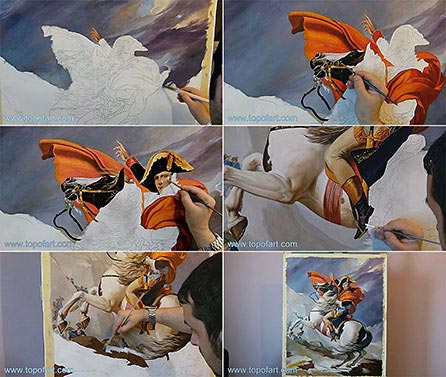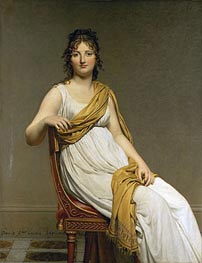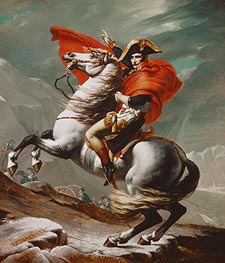Napoleon Crossing the Alps on 20th May 1800, 1803 Jacques-Louis David (1748-1825)
Location: Museum of Palace of Versailles Paris FranceOriginal Size: 267 x 223 cm
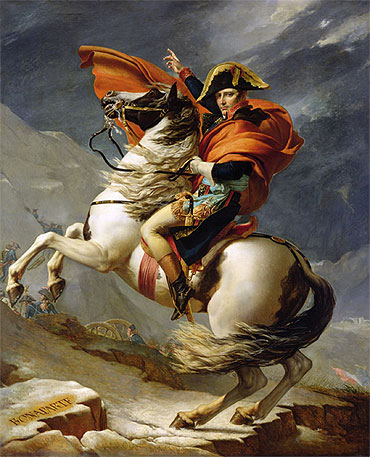
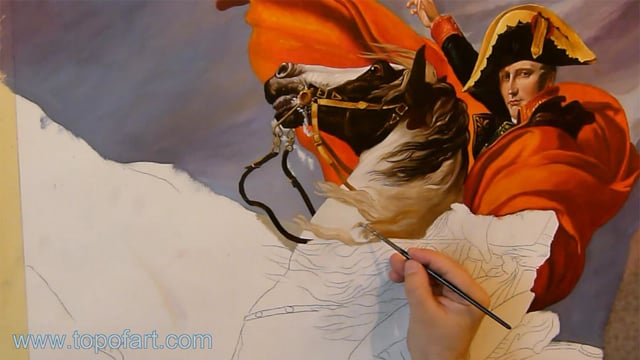 Napoleon Crossing the Alps on 20th May 1800 - Video
Napoleon Crossing the Alps on 20th May 1800 - Video
A Glimpse into Our Studio: Creating Museum-Quality Oil Painting Reproductions
Watch a video showcasing the creation of a hand-painted reproduction of Napoleon Crossing the Alps on 20th May 1800 by Jacques-Louis David in our TOPofART studio. Witness the step-by-step process as our artists bring this masterpiece to life.
Oil Painting Reproduction
If you want a different size than the offered
Description
Painted by European Аrtists with Academic Education
Museum Quality
+ 4 cm (1.6") Margins for Stretching
Creation Time: 8-9 Weeks
Creation Process
We create our paintings with museum quality and covering the highest academic standards. Once we get your order, it will be entirely hand-painted with oil on canvas. All the materials we use are the highest level, being totally artist graded painting materials and linen canvas.
We will add 1.6" (4 cm) additional blank canvas all over the painting for stretching.
High quality and detailing in every inch are time consuming. The reproduction of Jacques-Louis David also needs time to dry in order to be completely ready for shipping, as this is crucial to not be damaged during transportation.
Based on the size, level of detail and complexity we need 8-9 weeks to complete the process.
In case the delivery date needs to be extended in time, or we are overloaded with requests, there will be an email sent to you sharing the new timelines of production and delivery.
TOPofART wants to remind you to keep patient, in order to get you the highest quality, being our mission to fulfill your expectations.
We not stretch and frame our oil paintings due to several reasons:
Painting reproduction is a high quality expensive product, which we cannot risk to damage by sending it being stretched.
Also, there are postal restrictions, regarding the size of the shipment.
Additionally, due to the dimensions of the stretched canvas, the shipment price may exceed the price of the product itself.
You can stretch and frame your painting in your local frame-shop.
Delivery
Once the painting Napoleon Crossing the Alps on 20th May 1800 is ready and dry, it will be shipped to your delivery address. The canvas will be rolled-up in a secure postal tube.
We offer free shipping as well as paid express transportation services.
After adding your artwork to the shopping cart, you will be able to check the delivery price using the Estimate Shipping and Tax tool.
Museum Quality
The paintings we create are only of museum quality. Our academy graduated artists will never allow a compromise in the quality and detail of the ordered painting. TOPofART do not work, and will never allow ourselves to work with low quality studios from the Far East. We are based in Europe, and quality is our highest priority.
Additional Information
Background
Having taken power in France during the 18 Brumaire on 9 November 1799, Napoleon determined to return to Italy to reinforce the French troops still in the country and retake the territory seized by the Austrians in the preceding years. In the spring of 1800 he led the Reserve Army across the Alps through the Great St. Bernard Pass. The Austrian forces, under Michael von Melas, were laying siege to Massena in Genoa and Napoleon hoped to gain the element of surprise by taking the trans-Alpine route. By the time Napoleon's troops arrived, Genoa had fallen; but he pushed ahead, hoping to engage the Austrians before they could regroup. The Reserve Army fought a battle at Montebello on 9 June before eventually securing a decisive victory at the Battle of Marengo.
The installation of Napoleon as First Consul and the French victory in Italy allowed for a rapprochement with Charles IV of Spain. While talks were underway to re-establish diplomatic relations, a traditional exchange of gifts took place. Charles received Versailles-manufactured pistols, dresses from the best Parisian dressmakers, jewels for the queen, and a fine set of armour for the newly reappointed Prime Minister, Manuel Godoy. In return Napoleon was offered sixteen Spanish horses from the royal stables, portraits of the king and queen by Goya, and the portrait that was to be commissioned from David. The French ambassador to Spain, Charles-Jean-Marie Alquier, requested the original painting from David on Charles' behalf. The portrait was to hang in the Royal Palace of Madrid as a token of the new relationship between the two countries. David, who had been an ardent supporter of the Revolution but had transferred his fervour to the new Consulate, was eager to undertake the commission.
On learning of the request, Bonaparte instructed David to produce three further versions: one for the Chateau de Saint-Cloud, one for the library of Les Invalides, and a third for the palace of the Cisalpine Republic in Milan. A fifth version was produced by David and remained in various of his workshops until his death.
History of the five versions
The original painting remained in Madrid until 1812, when it was taken by Joseph Bonaparte after his abdication as King of Spain. He took it with him when he went into exile in the United States, and it hung at his "Point Breeze" estate near Bordentown, New Jersey. The painting was handed down through his descendants until 1949, when his great grand-niece, Eugenie Bonaparte, bequeathed it to the museum of the Chateau de Malmaison.
The version produced for the Chateau de Saint-Cloud from 1801 was removed in 1814 by the Prussian soldiers under von Blucher who offered it to the King of Prussia. It is now held in the Charlottenburg Palace in Berlin.
The 1802 copy from Les Invalides was taken down and put into storage on the Bourbon Restoration of 1814; but in 1837, under the orders of Louis-Philippe, it was rehung in his newly declared museum at the Palace of Versailles, where it remains to the present day.
The 1803 version was delivered to Milan but confiscated in 1816 by the Austrians. However, the people of Milan refused to give it up and it remained in the city until 1825. It was finally installed at the Belvedere in Vienna in 1834. It remains there today, now part of the collection of the Osterreichische Galerie Belvedere.
The version kept by David until his death in 1825 was exhibited at the Bazar Bonne-Nouvelle in 1846 (where it was remarked upon by Baudelaire). In 1850 it was offered to the future Napoleon III by David's daughter, Pauline Jeanin, and installed at the Tuileries Palace. In 1979, it was given to the museum at the Palace of Versailles.
Paintings
The commission specified a portrait of Napoleon standing in the uniform of the First Consul, probably in the spirit of the portraits that were later produced by Antoine-Jean Gros, Robert Lefevre and Jean Auguste Dominique Ingres, but David was keen to paint an equestrian scene. The Spanish ambassador, Ignacio Muzquiz, informed Napoleon and asked him how he would like to be represented. Napoleon initially requested to be shown reviewing the troops but eventually decided on a scene showing him crossing the Alps.
In reality the crossing had been made in fine weather and Bonaparte had been led across, mounted on a mule, by a guide. However, from the outset the painting was first and foremost propaganda, and Bonaparte asked David to portray him "calm, mounted on a fiery steed" (Calme sur un cheval fougueux), and it is probable that he also suggested the addition of the names of the other great generals who had led their forces across the Alps: Hannibal and Charlemagne (as Karolus Magnus).
Production
Few drafts and preparatory studies were made, contrary to David's normal practice. Gros, David's pupil, produced a small oil sketch of a horse being reined in, which was a probable study for Napoleon's mount, and the notebooks of David show some sketches of first thoughts on the position of the rider. The lack of early studies may in part be explained by Bonaparte's refusal to sit for the portrait. He had sat for Gros in 1796 on the insistence of Josephine de Beauharnais, but Gros had complained that he had not had enough time for the sitting to be of benefit. David had also managed to persuade him to sit for a portrait in 1798, but the three hours that the fidgety and impatient Bonaparte had granted him did not give him sufficient time to produce a decent likeness. On accepting the commission for the Alpine scene, it appears that David expected that he would be sitting for the study, but Bonaparte refused point blank, not only on the basis that he disliked sitting but also because he believed that the painting should be a representation of his character rather than his physical appearance:
- Sit? For what good? Do you think that the great men of Antiquity for whom we have images sat?
- But Citizen First Consul, I am painting you for your century, for the men who have seen you, who know you, they will want to find a resemblance.
- A resemblance? It isn't the exactness of the features, a wart on the nose which gives the resemblance. It is the character that dictates what must be painted...Nobody knows if the portraits of the great men resemble them, it is enough that their genius lives there.
The refusal to attend a sitting marked a break in the portraiture of Napoleon in general, with realism abandoned for political iconography: after this point the portraits become emblematic, capturing an ideal rather than a physical likeness.
Unable to convince Napoleon to sit for the picture, David took a bust as a starting point for his features, and made his son perch on top of a ladder as a model for the posture. The uniform is more accurate, however, as David was able to borrow the uniform and bicorne worn by Bonaparte at Marengo. Two of Napoleon's horses were used as models for the "fiery steed": the mare "la Belle" which features in the version held at Charlottenburg, and the famous grey Marengo which appears in those held at Versailles and Vienna. Engravings from Voyage pittoresque de la Suisse served as models for the landscape.
The first of the five portraits was painted in four months, from October 1800 to January 1801. On completion of the initial version, David immediately began work on the second version which was finished on 25 May, the date of Bonaparte's inspection of the portraits at David's Louvre workshop.
Two of David's pupils assisted him in producing the different versions: Jerome-Martin Langlois worked primarily on the first two portraits, and George Rouget produced the copy for Les Invalides.
Composition
The composition is based on simple geometrical forms. The principal subject fits in a circle delimited by the tail of the horse and the tip of the cloak. The pommel of the sword is at the centre of this circle. Napoleon and his horse form a Z-shape, giving dynamism to the scene, and the diagonals of the mountains and the clouds are opposing each other, reinforcing the impression of movement. In spite of the dynamic aspects of the composition, the scene appears static, due in the main to the lighting with which David illuminate his subject, giving the picture the feeling of a bas-relief.
Technique
In contrast to his predecessors Francois Boucher and Jean-Honore Fragonard, who employed a red or grey undercoat as a base colour on which to build up the painting, David employed the white background of the canvas directly underneath his colours, as some of his unfinished works show, such as his first attempt at a portrait of Bonaparte or his sketch of the Tennis Court Oath.
David worked using two or three layers. After having captured the basic outline with an ochre drawing, he would flesh out the painting with light touches, using a brush with little paint, and concentrating on the blocks of light and shade rather than the details. The results of this technique are particularly noticeable in the original version of Napoleon Crossing the Alps from Malmaison, especially in the treatment of the rump of the horse. With the second layer, David concentrated on filling out the details and correcting possible defects.
The third and last layer was used for finishing touches: blending of tones and smoothing the surface. David often left this task to his assistants.
Detail
All five versions of the picture are of roughly the same large size (2.6/2.2 m). Bonaparte appears mounted in the uniform of a general in chief, wearing a gold-trimmed bicorne, and armed with a Mamluk-style sabre. He is wreathed in the folds of a large cloak which billows in the wind. His head is turned towards the viewer, and he gestures with his right hand toward something ahead of him. His left hand grips the reins of his stead. The horse rears up on its back legs, its mane and tail whipped against its body by the same wind that inflates Napoleon's cloak. In background a line of the soldiers interspersed with artillery make their way up the mountain. Dark clouds hang over the picture and in front of Bonaparte the mountains rise up sharply. In the foreground BONAPARTE, ANNIBAL and KAROLVS MAGNVS IMP. are engraved on rocks. On the breastplate yoke of the horse, the picture is signed and dated.
Differences between the five versions
In the original version held at Malmaison (260/221 cm; 102/87 in), Bonaparte has an orange cloak, the crispin (cuff) of his gauntlet is embroidered, the horse is piebald, black and white, and the tack is complete and includes a standing martingale. The girth around the horse's belly is a dark faded red. The officer holding a sabre in the background is obscured by the horse's tail. The Napoleon's face appears youthful. The painting is signed in the yoke of the breastplate: L. DAVID YEAR IX.
The Charlottenbourg version (260/226 cm; 102/89 in) shows Napoleon in a red cloak mounted on a chestnut horse. The tack is simpler, lacking the martingale, and the girth is grey-blue. There are traces of snow on the ground. Napoleon's features are sunken with the faint hint of a smile. The picture is signed L.DAVID YEAR IX.
In the first Versailles version (272/232 cm; 107/91 in), the horse is a dappled grey, the tack is identical to that of the Charlottenbourg version, and the girth is blue. The embroidery of the gauntlet is simplified with the facing of the sleeve visible under the glove. The landscape is darker and Napoleon's expression is sterner. The picture is not signed.
The version from the Belevedere (264/232 cm; 104/91 in) is almost identical to that of Versailles but is signed J.L.DAVID L.ANNO X.
The second Versailles version (267/230 cm; 105/90 in) shows a black and white horse with complete tack but lacking the martingale. The girth is red. The cloak is orange-red, the collar is black, and the embroidery of the gauntlet is very simple and almost unnoticeable. The scarf tied around Napoleon's waist is light blue. The officer with the sabre is again masked by the tail of the horse. Napoleon's features are older, he has shorter hair, and – as in the Charlottenbourg version - there is the faint trace of a smile. Details of the clothing: the embroidery and the style of the bicorne suggest that the picture was completed after 1804. The picture is not dated but is signed L.DAVID.
